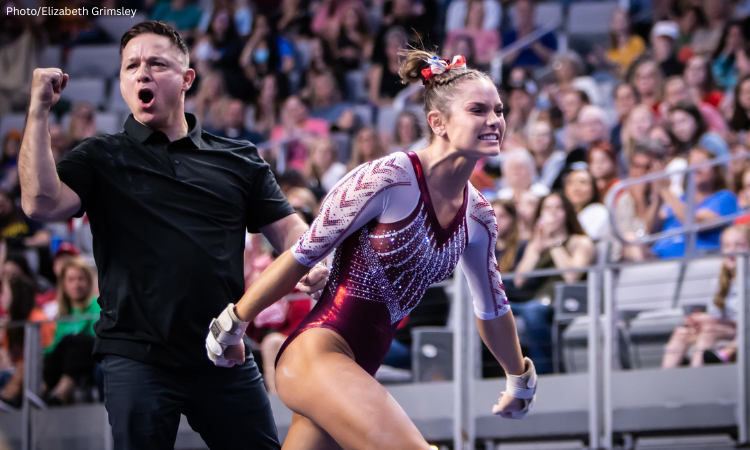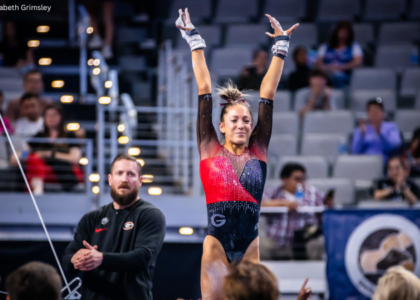Oklahoma’s dominance in women’s collegiate gymnastics is undeniable. While it is apparent across all four events, it has been most noticeable on vault.
Since 2014, the Sooners have not finished the regular season ranked lower than No. 4 on vault. When the Yurchenko full was downgraded to a 9.950 start value in 2015, it gave the Sooners the opportunity to set themselves apart from other teams in the country. It also allowed their individual athletes to shine. Oklahoma stars like Maggie Nichols, Brenna Dowell, and Anastasia Webb all won national titles on the event. Since 2014, seven additional Sooners have been in the top 10 during the regular season, with the most recent being Jordan Bowers and Katherine LeVasseur, both of whom compete a Yurchenko one and a half.
The secret to a good vault team lies not only with the athletes themselves but also in how they are coached. Enter vault coach Lou Ball. He’s a former vault and floor specialist at the University of Nebraska, who, according to his team, is the glue that holds the vault squad together.
“He’s turned [Oklahoma] into a vault team,” said Trautman, who is now a student coach after her time as an athlete under Ball. “He’s great at all of the technical stuff, from starting with your run and building all the way to the landing of the vault. [He knows] all the little things that make each turn work well.”
As an athlete, Ball credited his club and college coaches for laying the foundation for his athletic success. As he began his coaching career, he tried to take the best things from each coach to become the best he could be. Though it was an adjustment to transition from coaching men’s gymnastics to women’s, Ball continues to learn and gather knowledge from those around him to build his evolving philosophy.
Part of that philosophy is the idea that despite what others might believe, not everyone can be a vaulter. “There’s kids that have it walking in the door, and you’re just trying not to mess it up. [Others] you’re trying to slightly tweak to make it better than it was. [Some] have gone from having good raw power—but not that good technically—that we’ve managed to develop. We’ve seen both ends of the spectrum.”
Creating a consistently good vault team over a decade starts with recruiting. When identifying future Sooners, Ball looks for different elements in potential vaulters: an athlete’s power, from the strength of the legs to the technique from the run, all the way through the mechanics she uses to leave the table. While some may not have power in terms of strength, some athletes have it through the quickness and speed generated throughout their vault.
One such athlete that relies on quickness and speed is senior LeVasseur. Currently competing all-around for the Sooners, LeVasseur wasn’t always known for her prowess on this power event. “I used to struggle on vault in club. My third year of level 10, something clicked and I was able to vault. I’ve gotten better since I’ve been at OU because of Lou and his coaching and building my confidence on vault.”
During her freshman season, LeVasseur topped out at 9.925 on her Yurchenko one and a half, averaging a 9.835. The summer between her freshman and sophomore seasons, LeVasseur says that her adjustment to Ball’s coaching brought her further along in that event. “He learned my vault and the little things that helped me, like watching the table, punching the board, using my eyes on the landing throughout the air and seeing the landing.”
The work it takes to locate those little things to improve each athlete’s vault starts in the gym. The Sooners train vault every other day, switching it out with floor. After a stretch and run, the drills begin. From round-off technique and work on body positioning to round-off one and a halves onto four-inch mats and on the Tumbl Trak to build awareness, every drill is based on what individual needs the athletes have.
After warmups, then come timers. First is the “typical timer,” where mats are placed behind the vault to get a feel for the skill. Next, the vault progresses, starting with a Yurchenko layout, followed by the Yurchenko full, then anywhere from five to six Yurchenko one and a halves, depending on how the skill looks that day. If an athlete needs additional work throughout the process, they will sometimes do more of one variation than another to build their technique.
When it comes time to pick lineups, Ball compares it to a math equation. Currently, there are anywhere from 10 to 14 athletes with a competitive vault, almost all of them in the Yurchenko family; freshman Hannah Scheible competes the lone non-Yurchenko with her front handspring pike half. And with so many options to choose from, building a lineup that can deliver in pressure situations is based around multiple different strategies. But for Ball, it comes down to trust in his athletes. “You got to go off of history with each athlete and get a feel for what they are good at. The person that starts you [off should] be somebody that’s really strong, ultra consistent, and has the ability to start the team off [with not] just a hit but also land well.”
In 2019, Oklahoma became the first team to put up six 10.0 start values since the devaluation of the Yurchenko full, something Ball acknowledges is not an easy thing to do. “You’re weighing that half tenth. Essentially, that [Yurchenko] full’s got to stick or barely move to compete with the one and a half [that is] dynamic, high, straight, tight in the air,” Ball said. “If they stick, you’re still gaining that half of a tenth back.”
LeVasseur remembers the feeling of the first vault her sophomore season. It was against Alabama, and she stuck her landing for the first time, receiving her first career 10.0 on vault alongside her teammate Allie Stern. All of the hard work on those details, combined with Ball’s coaching, led to what she described as “a super special moment.” When the score flashed, she remembers what Ball said to her prior. “He said, ‘You have the cleanest vault. There’s nothing to take off besides the landing. Once you find that landing, you’re going to get a 10.'”
Finishing her career as the national vault champion, Trautman used the little cues Ball had given her throughout her years at Oklahoma to take home the title. Being on the awards podium at the end of the meet, she remembers Ball saying how proud he was of her. “He gave me a hug, and it was just an amazing moment.”
Oklahoma’s dominance continues into the postseason, as it heads to the national championships as the No. 1 national seed. While the Sooners have broken several program and NCAA records in 2024, they haven’t touched their vault high of 49.775, set in 2020. For that record to be broken, Ball says it’s going to take a phenomenal performance. “The day we stick five 10.0 start value vaults in today’s code, that’ll be the day that the record is broken. Do I think it’s possible? Yes. With what we have now and what we have coming in, I think it could happen at any time.”
READ THIS NEXT: Questions, Comments, Concerns: Regionals
Article by Savanna Wellman and Aaron Doyle





Hmm. We all know about the Sports Illustrated cover jinx. Is this the gymnastics equivalent? *laugh*